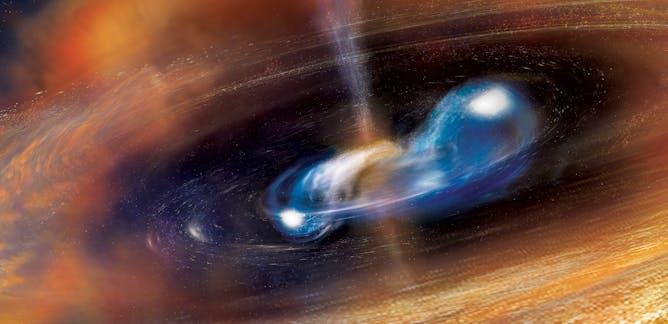It may be possible to use the brightest events in the universe, gamma ray bursts, to measure cosmic distances – which could help researchers figure out the universe’s structure
Space 2 August 2022

Gamma ray bursts occur when huge stars die in supernova explosions or when massive objects such as neutron stars smash together
NASA/Goddard Space Flight Center Scientific Visualization Studio
Blasts of gamma rays from the distant universe may provide a new way to measure cosmic distances. These gamma ray bursts (GRBs) could help us understand the structure and expansion of the universe.
GRBs are the brightest events in the universe. They occur when huge stars die in supernova explosions or when massive objects such as neutron stars smash together, producing powerful flashes of radiation.

Maria Giovanna Dainotti at the National Astronomical Observatory of Japan and her colleagues examined observations of 500 GRBs from some of the most powerful telescopes in existence, looking for common features in visible wavelengths of light that could tie some of these strange events together. They found that 179 of the GRBs in their sample exhibited an afterglow after the main explosion, probably caused by fast-spinning newborn neutron stars, with predictable properties.
Advertisement
“[The light has] a flat part called the plateau emission that is easier to standardise than the prompt emission, [which is] the main event of gamma ray bursts,” says Dainotti. By standardising the light – finding similarities in many of these GRBs and working out where they come from and what other properties of the GRBs they are related to – the researchers can turn these GRBs into so-called standard candles.
A standard candle is an object with a known brightness. By comparing this actual brightness with how bright the object seems from Earth, we can use it to measure distances. For extremely distant objects, this is the only way to tell how far away they are.
This is crucial because we need to understand precisely how far away the most distant galaxies are in order to calculate how fast the universe is expanding, which is represented by a number called the Hubble constant. Researchers have been arguing over this number for decades, and new standard candles are needed to sort out its true value. GRBs could be a step in the right direction but we need to find more of them before they can really make a dent in the debate, says Dainotti.





